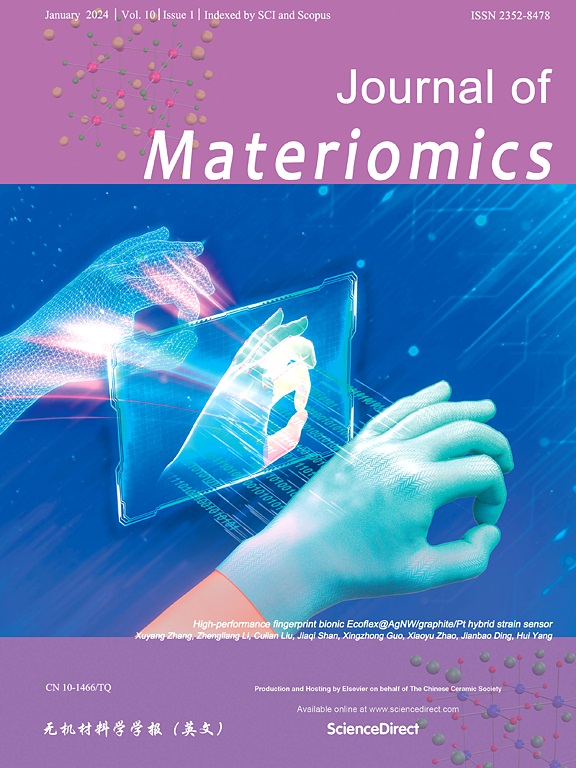Optimization of electro-strain and ferroelectric properties of P(VDF-TrFE) films under the synergistic effect of PTO nanosheets and in-situ electrostatic field
IF 8.4
1区 材料科学
Q1 CHEMISTRY, PHYSICAL
引用次数: 0
Abstract
Traditional ferroelectric materials, such as lead zirconate titanate (PZT) ceramics, exhibit positive strain when subjected to an electric field along the polarization direction. In contrast, the piezoelectric polymer polyvinylidene fluoride (PVDF) and its copolymer P(VDF-TrFE) display unique negative strain properties. While extensive research has focused on understanding the origin and mechanisms of this negative strain, limited efforts have been directed toward regulating these properties. This study optimizes the electro-strain and ferroelectric properties of P(VDF-TrFE) piezoelectric films through the synergistic effect of PbTiO3 nanosheets and an in-situ electrostatic field. Our results demonstrate that while the incorporation of PbTiO3 nanosheets does not notably enhance ferroelectricity, it significantly improves electro-strain properties, particularly negative strain, which increases from −0.097% to −0.185%, an enhancement of 91%. Moreover, the ferroelectric polarization and positive strain of P(VDF-TrFE) are further enhanced under the combined influence of PbTiO3 nanosheets and in-situ electrostatic field, increasing maximum polarization from 10.79 μC/cm2 to 13.16 μC/cm2, a 22% improvement, and positive strain from 0.213% to 0.267%, a 25% enhancement. We propose a possible mechanism for these improvements, attributed to the enhanced flexibility of the amorphous phase and increased content of polar β-phase in P(VDF-TrFE) films under this synergistic effect. This work highlights novel strategies for controlling the electro-strain and ferroelectric properties of P(VDF-TrFE) piezoelectric films.


在 PTO 纳米片和原位静电场的协同作用下优化 P(VDF-TrFE)薄膜的电应变和铁电特性
传统的铁电材料,如锆钛酸铅(PZT)陶瓷,在沿极化方向受到电场作用时会表现出正应变。相比之下,压电聚合物聚偏二氟乙烯(PVDF)及其共聚物 P(VDF-TrFE) 则显示出独特的负应变特性。虽然大量研究都集中在了解这种负应变的起源和机制上,但针对调节这些特性的研究却十分有限。本研究通过 PbTiO3 纳米片和原位静电场的协同作用,优化了 P(VDF-TrFE)压电薄膜的电应变和铁电特性。我们的研究结果表明,虽然 PbTiO3 纳米片的加入并没有显著增强铁电性,但却显著改善了电应变特性,尤其是负应变,从 -0.097% 增加到 -0.185%,提高了 91%。此外,在 PbTiO3 纳米片和原位静电场的共同影响下,P(VDF-TrFE) 的铁电极化和正应变进一步增强,最大极化从 10.79 μC/cm2 提高到 13.16 μC/cm2,提高了 22%,正应变从 0.213% 提高到 0.267%,提高了 25%。我们提出了这些改进的可能机制,即在这种协同效应下,P(VDF-TrFE) 薄膜中无定形相的柔韧性增强,极性 β 相的含量增加。这项工作突出了控制 P(VDF-TrFE)压电薄膜的电应变和铁电特性的新策略。
本文章由计算机程序翻译,如有差异,请以英文原文为准。
求助全文
约1分钟内获得全文
求助全文
来源期刊

Journal of Materiomics
Materials Science-Metals and Alloys
CiteScore
14.30
自引率
6.40%
发文量
331
审稿时长
37 days
期刊介绍:
The Journal of Materiomics is a peer-reviewed open-access journal that aims to serve as a forum for the continuous dissemination of research within the field of materials science. It particularly emphasizes systematic studies on the relationships between composition, processing, structure, property, and performance of advanced materials. The journal is supported by the Chinese Ceramic Society and is indexed in SCIE and Scopus. It is commonly referred to as J Materiomics.
 求助内容:
求助内容: 应助结果提醒方式:
应助结果提醒方式:


